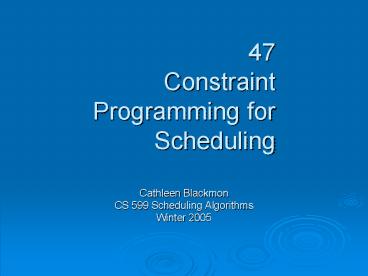47 Constraint Programming for Scheduling - PowerPoint PPT Presentation
1 / 15
Title:
47 Constraint Programming for Scheduling
Description:
CS 599 Scheduling Algorithms. Winter 2005. Constraint ... Domains reduced systematically using logic-based filtering algorithms ... CP algorithms perform better ... – PowerPoint PPT presentation
Number of Views:67
Avg rating:3.0/5.0
Title: 47 Constraint Programming for Scheduling
1
47 Constraint Programming for Scheduling
- Cathleen Blackmon
- CS 599 Scheduling Algorithms
- Winter 2005
2
Constraint Programming
- An approach for formulating and solving discrete
variable constraint satisfaction or constrained
optimization problems - Systematically employs deductive reasoning
- Reduce Search Space
- Allow for a Wide Variety of Constraints
- Extends Logic Programming
- More Powerful Search Strategies using
Problem-Specific Knowledge
3
The Constraint Satisfaction Problem - CSP
- Given
- A Set of Discrete Variables
- Associated Finite Domains
- Set of Constraints (involving the variables)
- Find
- A Solution that Satisfies all the Constraints
4
General Algorithmfor CSP (Constraint
Satisfaction Problem)
5
Constraint Propagation and Domain Reduction
Start
- Discrete Variables
- Boolean
- Integer
- Symbolic
- Set Elements
- Subsets of Sets
- Constraints
- Mathematical
- Disjunctive
- Relational
- Explicit
- Special Purpose
- If solution is found algorithm ends
- If no solution found, check for inconsistency
- Inconsistency The domain of at least one
variable has become empty.
- If inconsistency not proven,
- Then, search
- Using some strategy for branching
- Branching
- Divides the problem into subproblems
- Mutually exclusive
- Collectively exhaustive
- Select a branch
- Propagate all constraints again
- If inconsistency is proven (a failure), then
examine the search tree to see if all subproblems
have been explored.
- If all branches have been fathomed (explored)
- Then problem inconsistency has been proven
- If not, then backtrack to the previous stage and
branch to a different subproblem
1
Define variables Initialize variable
domains Initialize constraint store
- Domains reduced systematically using logic-based
filtering algorithms
- Then, the reduced domains are propagated to the
constraints that use those variables
2
Propagate constraints
3
Solution found ?
Yes
End1
No
4
5
Inconsistency proven ?
All branches fathomed ?
Yes
Yes
End2
6
7
No
No
Branch
Backtrack
6
Constraint Propagation - Example
7
Constraint Propagation Logic
Step1
C1 0, 1, 2, 3, 4, 5, 6
S1 0, 1, 2, 3, 4, 5, 6
C2 0, 1, 2, 3, 4, 5, 6
S2 0, 1, 2, 3, 4, 5, 6
C1 s1 3
C2 s2 2
C1 0, 1, 2, 3, 4, 5, 6
S1 0, 1, 2, 3, 4, 5, 6
C2 0, 1, 2, 3, 4, 5, 6
S2 0, 1, 2, 3, 4
Step2
C1 lt 5
Step3
C1 3, 4
either (C1 lt s2) or (C2 lt s1)
S1 0, 1
C1 s1 3
Step4
C2 5, 6
s2 3, 4
C2 s2 2
8
Branching
- Strategies
- Depth-first strategy - typical
- More sophisticated look-ahead strategies
- What to branch?
- First select variable whose domain is not yet
bound (not yet reduced to a single value) - Selection of variable based on heuristics
- Then instantiate variable again using
heuristics - Choice points ? The points at which the search
strategy chooses to advance along the search tree
9
Constraint Optimization Problem - COP
- Given Objective Z to be minimized
- When a first solution to the original CSP is
found - Calculate its objective value (Z)
- Add the constraint Z lt Z to the constraint store
(to form a new CSP) - Repeat the CSP algorithm on this new problem
- Repeat until inconsistency is found
- The last found solution is the optimum
10
Selected CP Applications
- Job Shop Scheduling
- Single-Machine Sequencing
- Parallel Machine Scheduling
- Timetabling
- Vehicle Dispatching
11
Research
- Hybrid methods for CP and IP search methodologies
- CPs strengths
- Flexibility in modeling
- Rich set of operators
- Domain reduction (combinatorial problems)
- IPs strengths
- Specialized search techniques
- I.E., Relaxation, cutting planes, duals
12
Modeling Scheduling Problems w/ CP
- Variable Indexing
- Constraints
- Inequalities
- Boolean variables
- Integer variables
- Logical constraints
- Global constraints
13
CP vs. IP Approaches
- IP
- Relies on the mathematical structure of the
problem - Objective-centric
- Generate-and-test strategy
- Constraints ? The fewer the better
- CP
- Constraints search strategy determined by the
researcher - Relies less on math. struct of prob
- - more on domain knowledge
- Constraint-centric
- Constant reevaluation of logical conclusions
resulting from interactions of constraints
reducing domain of feasible solns. - Constraints ? The more the better
14
Choosing the CP Methodology
- CP is most appropriate for
- Pure integer and Boolean decision variable
problems - (Not effective for floating-point)
- Combinatorial optimization problems with large
number of logical, global and disjunctive
constraints - Large num interrelated constraints with few
variables in each constraint - Better constraint propagation and domain
reduction - CP algorithms perform better
- Optimal mapping of one ordered set to another
relation btwn terms expressed in mathematical
terms significant to the objective
15
- Questions?































